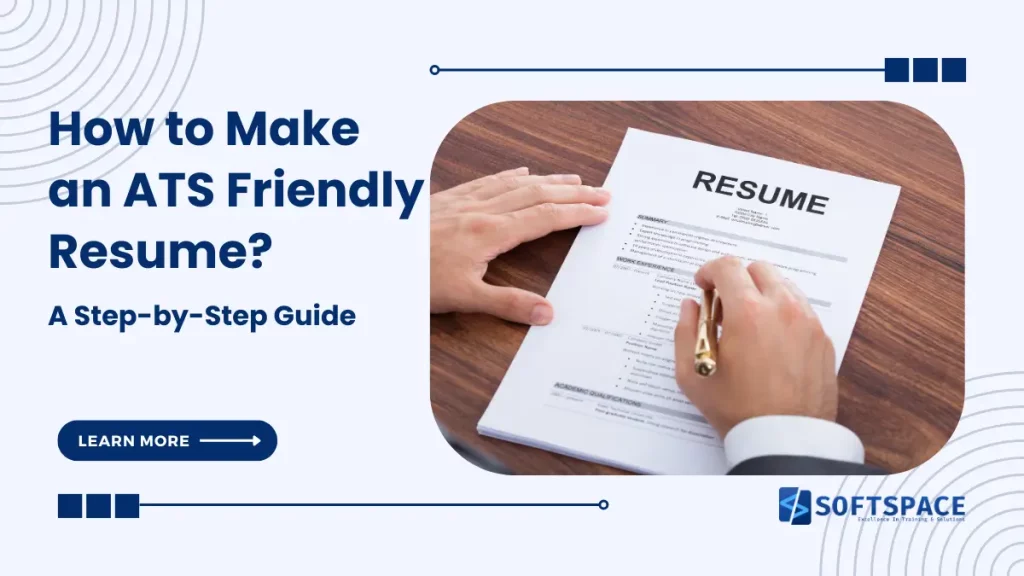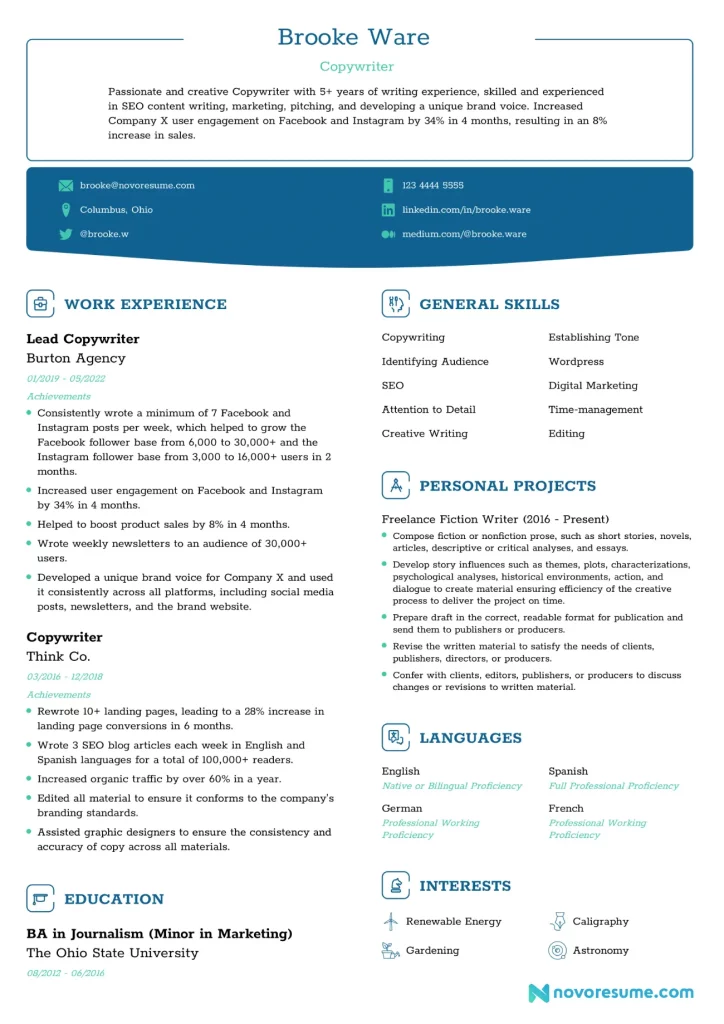In today’s competitive job market, many companies use Applicant Tracking Systems (ATS) to manage the flood of resumes they receive. An ATS is software that scans, sorts, and ranks job applications based on specific criteria set by employers. This automated system helps companies efficiently process large volumes of applications and identify the most qualified candidates.
How to Make an ATS Friendly Resume and Why? Because, if your resume isn’t optimized for these systems, it may be overlooked or rejected before a human recruiter ever sees it. An ATS-friendly resume increases your chances of making it past the initial screening and into the hands of hiring managers, significantly improving your job prospects.
This guide will cover key aspects of “How to Make an ATS Friendly Resume”, including:
- Choosing the right format and layout
- Optimizing content with relevant keywords
- Structuring your resume effectively
- Writing ATS-compatible job descriptions
- Testing your resume against ATS systems
- Avoiding common mistakes that trip up ATS software
By following these guidelines, you’ll learn how to create a resume that not only impresses human readers but also successfully navigates automated screening processes, giving you a competitive edge in your job search.
Table of Contents
Key Takeaways on How to make an ATS Friendly Resume?
- Use simple, clean formatting with standard fonts and a single-column layout
- Save your resume in ATS-compatible file formats (.docx or simple .pdf)
- Incorporate relevant keywords from the job description naturally throughout your resume
- Structure your resume with clear, standard section headings
- Use action verbs and quantify your achievements where possible
- Avoid complex designs, graphics, and special characters
- Tailor your resume for each application, focusing on the most relevant skills and experiences
How to make an ATS Friendly Resume?
There are a few factors to understand related to ATS friendly resume that you need to understand first. Let’s get into it.
What is an ATS
An Applicant Tracking System (ATS) is a software application used by employers to manage the recruitment process. It’s designed to collect, sort, scan, and rank job applications and resumes. ATS serves as a database for job applications and a tool to streamline the hiring process.
How does an ATS work?
ATS software works by:
- Collecting resumes from various sources (job boards, company websites, email)
- Parsing the information from resumes into a standardized format
- Scanning resumes for specific keywords and phrases related to job requirements
- Ranking applications based on how well they match the job criteria
- Allowing recruiters to search the database using specific parameters
- Sometimes automatically rejecting candidates who don’t meet minimum requirements
C. Why companies use ATS Companies employ ATS for several reasons:
- Efficiency: ATS can process hundreds or thousands of applications quickly, saving time and resources.
- Consistency: It provides a standardized method for evaluating candidates, reducing potential bias.
- Compliance: Many ATS help companies meet equal employment opportunity (EEO) requirements.
- Data management: ATS stores candidate information, making it easy to search and retrieve.
- Integration: It often integrates with other HR systems, streamlining the entire hiring process.
- Cost-effectiveness: By automating initial screenings, companies can reduce hiring costs.
- Improved quality of hire: ATS can help identify the most qualified candidates more accurately.
Understanding how ATS works and why companies use it is crucial for job seekers. It helps them tailor their resumes to increase their chances of passing through this initial automated screening and reaching human recruiters.
Recommended file types for ATS Friendly resume
- Preferred file types for ATS:
- .docx (Microsoft Word document)
- .pdf (Portable Document Format)
- Avoid:
- .jpg, .png, or other image files
- .txt (plain text files)
- Custom file types
Word documents (.docx) are generally the safest choice, as they’re easily readable by most ATS. While many modern ATS can handle PDFs, some older systems may have trouble parsing them correctly.
Optimal resume layout
- Use a simple, single-column layout
- Avoid:
- Multiple columns
- Tables
- Text boxes
- Headers and footers
- Graphics or images
- Use standard section headings (e.g., “Work Experience,” “Education”)
- Implement a consistent formatting structure throughout
A clean, straightforward layout ensures that the ATS can easily scan and categorize your information.
ATS-friendly fonts and formatting
- Fonts:
- Use common, sans-serif fonts (e.g., Arial, Calibri, Helvetica)
- Avoid fancy or unusual fonts
- Font size:
- 10-12 points for body text
- 14-16 points for headings
- Formatting:
- Use standard bold and italic formatting sparingly
- Avoid underlining, as it can be misread by some ATS
- Don’t use color to convey information
- Bullet points:
- Use standard, round bullet points
- Avoid special characters or custom bullets
This online resume maker ensures clean formatting to make your resume easily readable by both ATS and human recruiters. It also prevents potential parsing errors that could cause important information to be missed or misinterpreted by the ATS.
How to make an ATS Friendly Resume with relevant details?
Using relevant keywords
- Identify key terms from the job description and industry
- Incorporate these keywords naturally throughout your resume
- Include both acronyms and full terms (e.g., “CRM” and “Customer Relationship Management”)
- Use a mix of hard skills, soft skills, and industry-specific jargon
- Place important keywords near the top of your resume
- Avoid keyword stuffing, which can be flagged as spam
Keywords are crucial for ATS, as they’re used to match your resume to the job requirements. Using the right keywords increases your chances of passing the initial screening.
Tailoring your resume to the job description
- Carefully analyze the job posting for the required skills and qualifications
- Adjust your resume content to highlight experiences that match these requirements
- Use similar language and phrasing as found in the job description
- Prioritize information most relevant to the specific role
- Customize your professional summary or objective for each application
- Ensure your skills section aligns closely with the job requirements
Tailoring your resume shows that you’re a good fit for the specific role and helps your application rank higher in the ATS.
Avoiding graphics and special characters
- Don’t use images, logos, or other graphics
- Avoid special characters or symbols, including:
- Arrows
- Fancy bullet points
- Emojis
- Non-standard punctuation marks
- Use standard characters for section breaks (e.g., dashes or asterisks)
- Spell out numbers one through ten, and use numerals for 11 and above
- Use standard date formats (e.g., MM/YYYY or Month YYYY)
Graphics and special characters can confuse ATS software, leading to parsing errors or lost information. Sticking to plain text ensures that all your information is correctly read and categorized.
By optimizing your content for ATS, you’re not only increasing your chances of passing the automated screening but also making your resume more relevant and impactful for human reviewers. Remember, while it’s important to optimize for ATS, your resume should still read naturally and effectively communicate your qualifications to potential employers.
How to structure an ATS Friendly Resume?
Contact information
- Place at the top of your resume
- Include:
- Full name
- Phone number
- Professional email address
- City and state (full address not necessary)
- LinkedIn profile URL (optional)
- Avoid including personal information like age, marital status, or photo
B. Professional summary or objective statement
- Place directly below contact information
- Keep it concise (2-4 sentences)
- Tailor it to the specific job
- Include relevant skills and experiences
- Use keywords from the job description
- For experienced professionals: use a summary highlighting key achievements
- For entry-level or career changers: use an objective stating career goals
Work experience
- List in reverse chronological order
- Include:
- Job title
- Company name
- Dates of employment (month and year)
- 3-5 bullet points describing key responsibilities and achievements
- Use action verbs to start each bullet point
- Quantify achievements where possible
- Focus on results and impact rather than just duties
- Incorporate relevant keywords from the job description
Education
- List degrees in reverse chronological order
- Include:
- Degree Name
- Major/field of study
- Institution name
- Graduation date (or expected graduation)
- Include relevant coursework, academic achievements, or projects if you are a recent graduate
- Omit high school information unless it’s your highest level of education
Skills section
- Include a mix of hard skills (technical abilities) and soft skills (interpersonal traits)
- Prioritize the skills mentioned in the job description
- Group skills by category if you have many (e.g., Programming Languages, Software, Languages)
- Consider using a scale to indicate proficiency level (e.g., Expert, Advanced, Intermediate)
- Update this section for each job application to match the specific requirements
This structure provides a clear, logical flow of information that is easy for both ATS and human readers to follow. It prioritizes the most relevant information and ensures that key details are prominently displayed. Remember to maintain consistent formatting throughout each section to aid in ATS parsing and readability.
Writing ATS-Friendly Job Descriptions
Using action verbs
- Start each bullet point with a strong action verb
- Choose verbs that accurately describe your contributions
- Vary your verb choices to avoid repetition
- Examples of effective action verbs:
- Developed
- Implemented
- Managed
- Analyzed
- Streamlined
- Collaborated
- Increased
Action verbs make your descriptions more dynamic and highlight your proactive approach to work. They also help ATS systems better categorize your experiences.
Quantifying achievements
- Use numbers, percentages, and specific metrics where possible
- Provide context for your achievements
- Examples:
- “Increased sales by 25% over 6 months”
- “Managed a team of 12 developers”
- “Reduced customer complaints by 40% through improved service protocols”
- Be precise and honest in your quantifications
Quantifying achievements provides concrete evidence of your impact and helps both ATS and human readers quickly grasp the scope of your accomplishments.
Incorporating relevant keywords naturally
- Identify key terms from the job description
- Integrate these keywords into your job descriptions organically
- Use variations of keywords (e.g., “project management” and “managing projects”)
- Include industry-specific terms and acronyms
- Ensure the language flows naturally and doesn’t feel forced
- Example: Instead of: “Responsible for customer service” Try: “Provided excellent customer service, resolving an average of 50 inquiries daily with a 95% satisfaction rate”
Incorporating keywords naturally helps your resume rank higher in ATS results while still sounding authentic to human readers. It demonstrates your fit for the role and your understanding of industry terminology.
When writing ATS-friendly job descriptions, aim for a balance between optimization for automated systems and readability for humans. Each bullet point should be concise yet informative, ideally no longer than 1-2 lines. Focus on your most significant responsibilities and achievements that are most relevant to the job you’re applying for.
Testing Your ATS Friendly Resume
Using online ATS simulators
- Utilize free or paid online tools that mimic ATS scanning
- Popular options include Jobscan, Resume Worded, or TopResume
- Upload your resume and the job description
- Review the analysis for:
- Keyword match rate
- Skills gap identification
- Formatting issues
- Overall ATS compatibility score
- Make adjustments based on the feedback provided
These simulators can give you valuable insights into how well your resume might perform in actual ATS scans.
Seeking professional feedback
- Consider having your resume reviewed by:
- Career counsellors or coaches
- Professional resume writers
- Industry professionals or mentors
- Trusted colleagues
- Ask for specific feedback on:
- ATS compatibility
- Content relevance
- Clarity and conciseness
- Overall Impact
- Implement suggested improvements
Professional feedback can provide a human perspective on your resume’s effectiveness, complementing the automated analysis from ATS simulators.
Submitting to multiple job postings
- Apply to several relevant positions using your optimized resume
- Track your application progress and response rates
- Look for patterns in which applications advance and which don’t
- If you’re not getting responses:
- Re-evaluate your resume’s content and format
- Ensure you’re applying to appropriate positions
- Consider adjusting your keyword usage or overall strategy
- If you’re getting positive responses, note what might be working well
Real-world testing can provide the most accurate feedback on your resume’s performance. It allows you to gauge its effectiveness across different companies and ATS platforms.
Testing your ATS-friendly resume is crucial because it helps you identify areas for improvement before you apply to your target positions. It’s an iterative process – you may need to make several adjustments based on the results of your tests.
Common mistakes to avoid in your ATS Friendly Resume
Overusing keywords (keyword stuffing)
- Definition: Excessive repetition of keywords to try to game the ATS
- Why it’s a problem:
- Can be flagged as spam by ATS
- Makes the resume difficult for humans to read
- May come across as dishonest or desperate
- How to avoid:
- Use keywords naturally and in context
- Aim for a balanced keyword density
- Focus on quality over quantity of keyword usage
- Ensure your resume still flows well when read by a person
Using incompatible file formats
- Common incompatible formats:
- .jpg, .png, or other image files
- Non-standard word processing formats
- Heavily formatted PDFs
- Why it’s a problem:
- ATS may not be able to parse the information correctly
- Can result in missing or garbled text
- May cause automatic rejection of the application
- How to avoid:
- Stick to .docx or simple .pdf formats
- Test your file with an ATS simulator before submitting
- When in doubt, follow the employer’s specified format preferences
Relying on complex designs or templates
- Problematic design elements:
- Multiple columns
- Text boxes
- Graphics or images
- Fancy fonts or excessive formatting
- Headers and footers
- Why it’s a problem:
- ATS may not read information in the correct order
- Important details might be overlooked or misinterpreted
- Can lead to parsing errors and data loss
- How to avoid:
- Use a simple, single-column layout
- Stick to standard section headings
- Use common, easy-to-read fonts
- Rely on basic formatting (bold, italics) sparingly
- Prioritize content over design
By avoiding these common mistakes, you increase the chances of your resume successfully passing through ATS screening and reaching human recruiters. Remember, while it’s important to create an ATS-friendly resume, it should still be readable and appealing to the human eye. The goal is to create a document that balances technical optimization with compelling content presentation.
Conclusion
So, how to make an ATS friendly resume? In today’s competitive job market, creating an ATS-friendly resume is no longer optional—it’s essential. As more companies rely on Applicant Tracking Systems to streamline their hiring processes, your resume must be optimized not just for human eyes, but also for these automated screeners.
An ATS-friendly resume significantly increases your chances of making it past the initial screening and into the hands of hiring managers, bringing you one step closer to landing your dream job.
Remember, while optimizing for ATS is crucial, your resume should still read well to human reviewers. Strive for a balance between ATS compatibility and compelling content that showcases your unique value as a candidate.
We encourage you to implement these strategies in your job search. Take the time to review and revise your current resume using the guidelines provided. Test your resume using ATS simulators and seek feedback from professionals in your field. By creating an ATS-friendly resume, you’re not just adapting to current hiring practices—you’re giving yourself a competitive edge in your job search.
Your resume is often your first opportunity to make an impression on potential employers. Make it count by ensuring it’s both ATS-friendly and impactful. With these strategies in hand, you’re well-equipped to craft a resume that will successfully navigate automated systems and impress human recruiters alike. Good luck in your job search!

13+ Yrs Experienced Career Counsellor & Skill Development Trainer | Educator | Digital & Content Strategist. Helping freshers and graduates make sound career choices through practical consultation. Guest faculty and Digital Marketing trainer working on building a skill development brand in Softspace Solutions. A passionate writer in core technical topics related to career growth.





